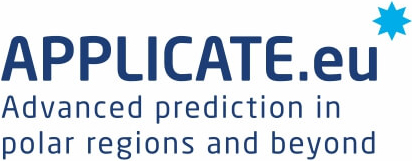Observing system design
One of APPLICATE’s objectives is to provide guidance for a better exploitation of existing observational datasets and the optimal design of future observing systems.
This guidance will be based on
(1) an assessment of the representation of the natural climate variability in the Arctic in long-term reanalyses,
(2) the use of observations for process understanding of the Arctic weather/climate and its linkages to lower latitudes, and
(3) the enhancement of initial condition accuracy leading to improved forecast skill from short/medium-to-seasonal time scales.
Guidance for future observing system configurations will be provided by making use of model experiments and by focusing on data-rich periods such as YOPP. In this framework, the aspect of prediction will be central.
WP4 in particular will define an experimentation plan to
(i) characterize the sensitivity of forecast skill across time ranges to the initial conditions in the atmosphere, the cryosphere and ocean,
(ii) define the key observations that are crucial for constraining physical processes and their coupling,
(iii) define temporal and spatial sampling set-ups, and
(iv) employ key metrics for assessing skill as compiled in WP1.
Selected publications
- Blockley, E. W. and Peterson, K. A. (2018): Improving Met Office seasonal predictions of Arctic sea ice using assimilation of CryoSat-2 thickness. The Cryosphere, 12, 3419–3438, https://doi.org/10.5194/tc-12-3419-2018
- Lawrence H, Bormann N, Sandu I, Day J, Farnan J, Bauer P. (2019).Use and impact of Arctic observations in the ECMWF Numerical Weather Prediction system. Q J R Meteorol Soc.; 145:3432–3454. https://doi.org/10.1002/qj.3628
- Massonnet, F. (2019). Climate Models as Guidance for the Design of Observing Systems: the Case of Polar Climate and Sea Ice Prediction. Curr Clim Change Rep 5, 334–344. https://doi.org/10.1007/s40641-019-00151-w
- Ponsoni, L., Massonnet, F., Docquier, D., Van Achter, G., and Fichefet, T., 2020: Statistical predictability of the Arctic sea ice volume anomaly: identifying predictors and optimal sampling locations, The Cryosphere, 14, 2409–2428, https://doi.org/10.5194/tc-14-2409-2020.
